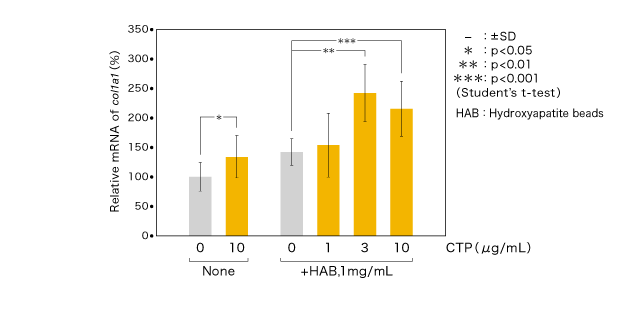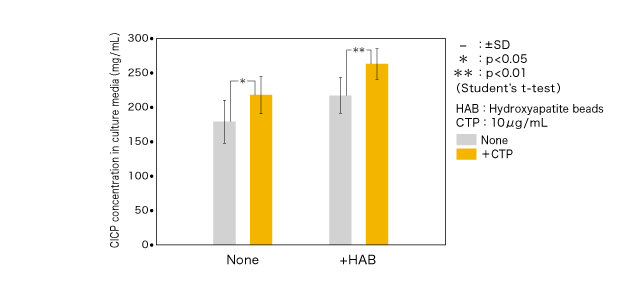
Promotion of collagen production (in vitro)
90% of bone matrix consists of collagen produced by the osteoblast. Therefore, we studied what effect CTP gives against collagen production in bones at "gene expression" and "protein synthesis" levels.
Test for promotion of collagen production in osteoblast
1) Methods
- <Test sample>
- CTP was prepared.
- <Measurement method>
- First, human osteoblasts (hF0B1.19, ATCC) which can control cell growth and differentiation depending on incubation temperatures by introducing temperature-sensitive SV40 large T antigen gene were cultivated in 24-well plate up to a confluent state in 10% FBS-DMEM/HAM F12 at 34°C. Preincubation was carried out at 39°C for 24 hours after changing the medium to 1% FBS-DMEM/HAM F-12. Next , they were cultivated by adding CTP and hydroxyapatite beads (HAB) at 39°C for 24 hours.
The total RNA extracted from the cells recovered after above cultivations was subjected to quantitative measurement of mRNA in Col1a1 by real time PCR using TaqMan® probe which is specifically binding to type I collagen gene (Col1a1). At that time, we corrected the quantity of mRNA in each test sample based on that of mRNA in GAPDH: a housekeeping gene as an internal standard. Furthermore, we evaluated type I collagen production amount by quantitative measurement of C-terminal propeptides (CICP) of type I collagen which is an index of collagen production in bone, according to the ELISA method.
2) Results

The analysis result of the expression quantity of Col1a1 is shown in Figure 1. By adding CTP, the expression amount of Col1a1 was increased by 1.4 times, and promotion of collagen production was recognized at the transcriptional level. Moreover, under the condition of additional hydroxyapatite (shown as "+HAB. 1 mg/mL") which is a major structural component of the bone that is closer to in vivo condition, the group with CTP addition of 3 μg/mL showed an increase of Col1a1 expression by approx.1.7 times of the CTP non-addition group. Moreover, it was approx. 2.4 times when it compared with the group that added neither CTP nor HAB ("None").
As in Figure 2, the ELISA method analysis showed that the secretional capacities of CICP brought by CTP addition under additional or non-additional hydroxyapatite conditions were both increased. In other words, it was also confirmed that CTP promoted collagen production at the protein level.
Figure 1: Expression quantity of type I collagen gene (Col1a1)

Figure 2: Secretional capacity of CICP

3) Discussion

CTP in collagen increased collagen production amount in the human osteoblasts. Therefore, we can expect that ingestion of CTP-containing collagen will greatly contribute to maintainenance and promotion of healthy bones.



